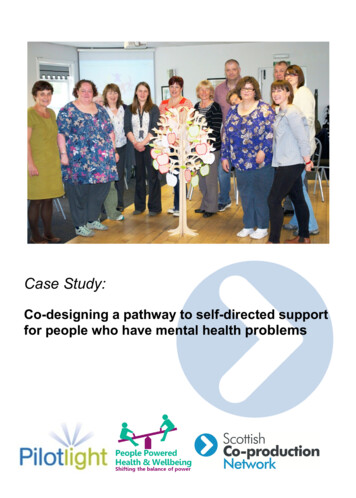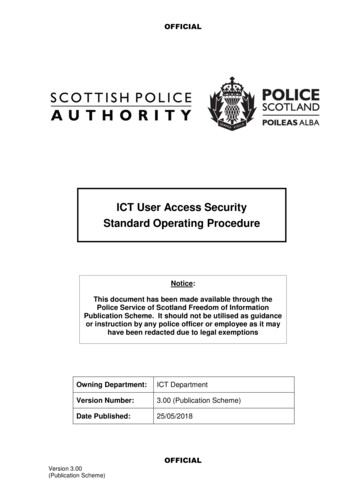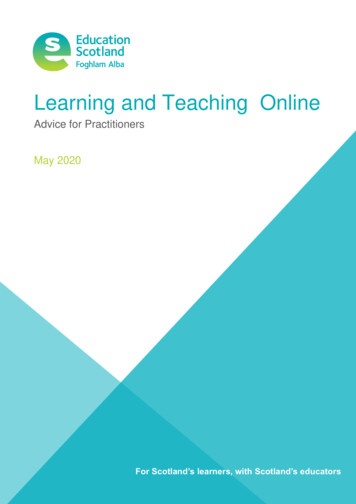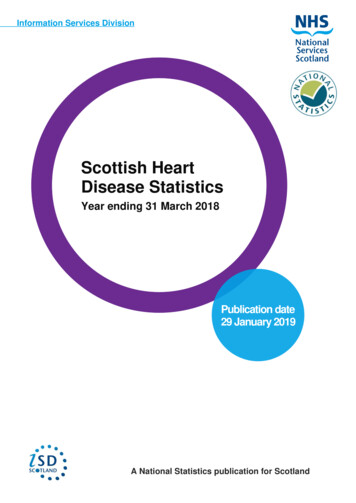
Transcription
Case Study:Co-designing a pathway to self-directed supportfor people who have mental health problems
Background – Self Directed Support inScotlandThe Social Care (Self-directed Support)(Scotland) Act 2013 went live on the 1stApril 2014 and the implementation of theNational Strategy is well under wayacross Scotland.Pilotlight is part of the ‘Changing Support,Changing Lives’ programme that aims tosupport providers to make thetransformation to self-directed support inScotland. It does so by working with codesign teams of people who use anddeliver services across Scotland to designpathways to self-directed support.Pilotlight is hosted by the Institute forResearch and Innovation in SocialServices. IRISS’s role is to promotepositive outcomes for the people who useScotland’s social services by enhancingthe capacity and capability of the socialservices workforce to access and makeuse of knowledge and research forservice innovation and improvement.In Moray, the aim was to co-design apathway to improve access to SelfDirected Support (SDS) for people withmental health problems. Moray Councilwere undertaking a self-directed supportpilot but had not managed to involvepeople with mental health problems.It took the opportunity available to bring inthe design and facilitation experience ofthe IRISS Pilotlight facilitators to set up aco-design team involving council healthand social work staff, Scottish Associationfor Mental Health (SAMH), people whoaccess support and an unpaid carer tohelp it look at how it engaged with peoplewho had mental health problems aroundself-directed support.2Pilotlight had specific intended outcomes,mainly: To identify barriers that hinder accessto self-directed support andencourage organisations to overcomethese. To deliver collaboratively designedservices and produced services andsupport. To increase the capacity of supportproviders to deliver a greater varietyof self-directed support and services. To lead thinking on designing betterservices.Ultimately Pilotlight will produce a serviceblueprint in the form of a ‘how to’ guidewhich will detail the co-design process,the service design tools used, the outputsfrom each of the pathways and some keylearnings.There were key underlying principles thatguided the work, including:Participation and inclusion – everyone,no matter their impairment, couldcontribute to the Pilotlight pathway.Non-discrimination and equality – everymember of the co-design team had anequal voice and was given the respectand treated with the dignity they deserved.Innovation and practical application –there was a focus on looking at howservices could be delivered differently butthat whatever came out of the co-designprocess should be likely to succeedor be effective in real circumstances.
Starting points:At the initial workshop the Pilotlightfacilitators explained Pilotlight and thepurpose of the project. The group,referred to hereon in as the co-designteam, also explored people’sunderstanding of wellbeing, theirknowledge of mental health services inMoray and their assessment of existingself-directed support services.Participants also agreed how often andwhen they would meet and how theywould work together in and between theworkshops.The co-design team also produced a‘Working Together Agreement’ coveringgeneral principles to guide workingtogether, mutual commitments in termsof preparation and attendance,conversational courtesies andcommunications and media matters.co-design team might make. They alsoused role play, focused on variousscenarios, to help illuminate thecharacters and to stimulate other ideas forco-designing solutions to the issues theyhad previously identified.The Pilotlight facilitators played key rolesduring these early sessions to facilitateshared understanding amongst the groupon a range of SDS topics and issues andstimulate a culture of ‘equality’ in terms ofcontribution of ideas. They also manageda range of practical tasks, includingrecording and writing up notes fromworkshop discussions, planning ahead forfuture sessions and keeping in touch withpeople between workshop sessions.Beginning to work together:Subsequent workshops spent timelooking in more detail at self-directedsupport from a range of perspectives.This involved research undertaken bysome of the co-design team in betweenworkshops with friends, family andcommunity members, practitionerexperience and desk researchundertaken by the Pilotlight facilitators.Developing the new pathway:Based upon the research findings, the codesign team agreed the themes theywished to work on.After the co-design team had developedthe ‘character profiles’ these were used asthe basis for producing more detailed‘design briefs’ and ‘prototypes.’They then developed ‘character profiles’of people who might use and deliver SDS.These acted as guides for thinking aboutthe goals and desires of people whoaccess support and in turn helped guidedecisions about the service that theParticipants split into 2 sub-groups to lookat information and assessment themes.The information group examined andprioritised ideas for how information couldbe better provided and made moreaccessible.3
The assessment group reviewed theCouncil’s current self-assessmentquestionnaire and suggested changesbased upon ideas generated through thecharacter profile development.At this point, the Pilotlight facilitatorsbrought in the IRISS Creative inResidence to work with the whole codesign team to develop their ideas for aninformation campaign. The ‘pick ’n’ mix’animation that they developed has sincebeen adopted by the Scottish Governmentand is available nationally through theweb and app version of the SDS UserGuidance which was published before theAct went live.Co-design team members did ‘homework’between workshops and then sharedfindings and ideas at the full workshopsessions. Learning from others’experience was also important and in thisrespect they also watched a video casestudy created by Stockport Council aboutpersonal budgets for people with mentalhealth problems.The co-design team then adopted asimilar character profile and design-ledapproach to looking at the themes of‘Learning and Development for MentalHealth Practitioners’ and ‘SDS for People4with Fluctuating Conditions.’The Learning and Development Groupconsidered what practitioners might needto learn about SDS, fears they might havein working with people who accesssupport and how they could be supportedin improving their learning.The Fluctuating Conditions group focusedon advance planning by those who accesssupport in times of crisis and what kind ofrisk management strategies might be putin place to help. They also looked at howSDS money could be managed for peoplewith fluctuating conditions. The group thendiscussed how members might like toshowcase the work that had been done inall 4 working groups during the Pilotlightproject.Some volunteered to showcase theproject at the forthcoming Moray FeelGood festival, a Moray Council informationday for service providers and 3 of themalso participated in an annual IRISSChampions event. The Pilotlight facilitatorsintroduced their creative design colleaguesinto the group at this stage to help developproducts to help showcase the project.The Pilotlight facilitators also did a hugeamount of ‘homework’ during this latterphase. This involved working up 5 full‘Design Briefs’ to capture the group’sideas for re-designing key elements ofSDS in Moray and liaising with theirknowledge media colleagues to create ashowcasing video involving some groupmembers.
Challenges:Outcomes:A number of challenges arose during thecourse of the project:The main outcome from this co-designprocess was the growth in confidence ofall members as they realised that they allhad important but different contributions tomake. This was a key feature of thelessons learned (see below) by variousmembers of the group. Helping everyone in the early stageslearn how to communicate and worktogether productively whereby allviews and ideas were equally valued. Ensuring everyone had sufficientinformation and understanding ofsocial services and SDS to enablethem to contribute fully Making sure that everyone shared inthe responsibility to make the projecta success – by attending regularly,doing work in between workshopsessions, testing out ideas withothers and helping showcasing theproject. 5Enabling all participants tounderstand co-design principles,relate their specific activities back tothe overall ‘double diamond’framework (see diagram on page 7below) and appreciate and value codesign as way of working inpartnership.The other major outcome is having 5Design Briefs that are considered all thebetter and more capable of practical useand implementation because they havebeen co-produced by service providers inthe Council and voluntary sector, workingtogether on an equal basis with those whouse SDS and their carers.The 5 Design Briefs are: An accessible information campaignbased upon a ‘pick ‘n mix’ theme. Guidance for Moray Council todevelop an Individual Service Fundfor people with fluctuating conditions. Content and methods to deliver SDSlearning and development. A revised mental health SelfAssessment Questionnaire, guidanceand scripts for a practice simulationtool. Advance planning for SDS “add on” tosupport planning.For some people who accesssupport, getting over initial feelings ofbeing scared, nervous and havingnothing to contribute.For providers, changing theirperceptions of people from ‘serviceusers’ to that of equal partners whocan offer insights and bring othervaluable experiences and skills.These are also represented in the diagramoverleaf.
Finally, there is also a legacy of greaterknowledge of co-design and coproduction from the experience of ‘doingit’ that can be shared and built on locallybut which has the potential to be madeavailable for others to learn from acrossScotland.This project demonstrated co-productionin practice by using a co-designframework as the basis for improvingaccess to self-directed support in Morayfor people with mental health problems.Judith and Kate, the Pilotlight facilitators,6worked with a co-design team comprisedof support providers, people who accesssupport, carers and other relevantstatutory agencies and local organisationsover a period of 8 months in a series ofworkshops.The visual nature of the design process ispresented overleaf.
Why is this co-production?The different ways in which co-productionwas put into practice are described below:AssetsPeople who access support and carerswere key members of the group set up todevelop the new Pathway. They led muchof the community research work thatshaped the service design briefs andwere pro-active in developing newprototypes, particularly the bespoke selfassessment questionnaire for mentalhealth. The project actively sought tocapture their knowledge and experienceof SDS and used them to tap into a widerpool of people who can access support.CapacityFrom the outset the Pilotlight team soughtto foster a culture and a partnership ofequals.7Individual people who access support andcarers were treated no differently fromother group members in terms of the valueof their ideas.They were encouraged and helped tocontribute to group decisions, be active inshowcasing the project and in acceptingtheir share of commitments andresponsibilities for the successfuloperation of the workshop sessions andwider project.MutualityThe key incentive for people who accesssupport was the opportunity to contributeinnovative ideas to re-designing SDS inMoray.There was also an incentive to put lessthan positive past experiences ofinvolvement with service providers behindthem and work jointly with them in aco-design process.
Practical incentives to aid theirparticipation were also on offer: wheresome tasks required additional timecommitment, the project offered afinancial payment (e.g. if participantsposted on the Pilotlight blog). A fee andtravel expenses were also paid to enablethose who access support and carers toattend workshop sessions.NetworksBy recognising the experience and widerconnections of those members of thegroup who access support and carers, theproject was able to test out its ideas withwider family and community networks.People who access support and carerswere also able to make use of othercommunity networks to help showcasethe project.Providers engaged with, and tested outideas, within their work teams, bringing inthe IRISS staff at key points in the project.Shared roleNo one partner was considered to be thelead member, control what shouldhappen, when and how during the project.In similar fashion, no one person or bodywas seen as being the “expert” or havingall the ideas or resources for devisingsolutions to the challenges or issuesidentified by the group.The work of the project was deliberatelyorganised in mixed pairs, working groupsand the links with wider networks madeequal use of professional networks (e.g.experience in Stockport), as well as localMoray family and community networks.The use of “creative tools” such as8“character profiles” helped everyoneparticipate on an equal basis and bevalued in their own right rather than byany title or organisational role.CatalystsThe Council recognised that it needed toimprove access to self-directed support inMoray for people with mental healthproblems.It used the experience of the project tohelp improve its own SDS pilot currentlyoperating at the same time.Key staff have realised that they do nothave to find all the answers or take all theresponsibility to improve the service butrather work more in partnership with thosewho use the service, enabling them tohelp shape it and make more of theexpertise of users and wider family andcommunity networks.Is the project current? / When did ittake place?The Pilotlight project took place betweenJanuary – September 2013. The projectas such has finished and the newproducts are now in place and relatedprocesses being implemented by the localpartners.
Are there any key areas of learningfrom this experience?There were a number of importantlessons - about what makes for moreeffective pathways to self-directedsupport for people with mental healthproblems and also what makes for asuccessful co-design process.More effective pathways to selfdirected support:“Experiencing the co-design and coproduction process – using people’sexperience and knowledge in ways thathelped build people’sconfidence.” (Mental Health Practitioner)“Realising that people with mental healthproblems have a different set of needsand that our questionnaire can’t begeneralised to different clientgroups.” (SDS Support Worker)“It’s made me think I could do this on apersonal level, so I have decided to go tocollege to do events coordinating, but Ijust think that I have got a brain here inmy head and that it can be a productivebrain.” (Day Centre Service User)“The co-design really worked because itput everybody on an equal footing,everybody has the same value, there’s noone person’s opinion more important thananybody else’s.” (SAMH Service User)“It’s been great that by working along withpeople who, I suppose I would have seenas ‘service users’ before and workingalong with them as partners, the insightthey have offered me to their experienceof using our services has just beenmassive.” (Service Manager)9“For me it’s seeing the service users whohave been involved in the process, I haveknown a lot of them for a long time and tosee them take control and flourish and fortheir ideas to be taken on board has beena great success.” (SAMH ServiceManager)Achieving successful co-design:In this particular project the co-designteam members from Moray used thedesign and facilitation skills of thePilotlight team in IRISS.That enabled other important lessonsabout co-design to be learned:Invest sufficient time in the whole project,not just the “contact” time withparticipants. This means time for researchand designing a process that works for allthe partners.Work in between the delivery sessions isvital – it helps everyone think ahead,keeps people engaged and everyonecomes better prepared to subsequentsession.Using the “double diamond” frameworkwas a useful tool – it provided a clearvisual of the process to be workedthrough, reminded everyone of the stagesreached and helped people engage.Make time at the start for listening anddeveloping understanding amongst theparticipants. Be prepared to use creativetools to remind people of any ground rulesagreed and to ease the process ofparticipants learning to work together.Develop a “working together” agreement –this helps anticipate individual goals
and is a useful reminder to checkprogress against intended outcomes.Don’t be afraid to use “creative tools” –they can provide simple but effectiveways to achieve the purpose of specificexercise or discussion and act as adeliberate link back to the overall process.Think about the combination of skills setsthat may be needed – ideally, combiningdesign skills with facilitation skills andknowledge of the topic but alsoconsidering what will help achieveeffective facilitation with mixed abilitygroups.Further informationThis case study was produced by theScottish Co-production Network, ScottishCommunity Development Centre,Pilotlight, IRISS and the ALLIANCE aspart of the People Powered Health andWellbeing programme.The aim of the People Powered Healthand Wellbeing programme is to ensurethat people are able to influence theirservices and supports for their own healthand wellbeing, and to contribute to thedesign, delivery and improvement ofsupport and services (including throughpeer support.) nd.org.ukThe Pilotlight video and more informationabout the project can be accessed atwww.pilotlight.iriss.org.ukThe Pick ’n’ Mix SDS accessibleinformation video can be accessed support10The Pick ’n’ Mix SDS accessibleinformation video can be accessed supportIRISS FM, the internet radio for ScotlandSocial Services has produced aprogramme which provides an audiorecording of the Pilotlight project and anoverview of the first Pilotlight Pathway inMoray.This can be accessed at http://irissfm.iriss.org.uk/episode/058
Background - Self Directed Support in Scotland-directed Support) (Scotland) Act 2013 went live on the 1st April 2014 and the implementation of the National Strategy is well under way across Scotland. Pilotlight is part of the 'Changing Support, Changing Lives' programme that aims to -directed support in Scotland. It does so by working .










